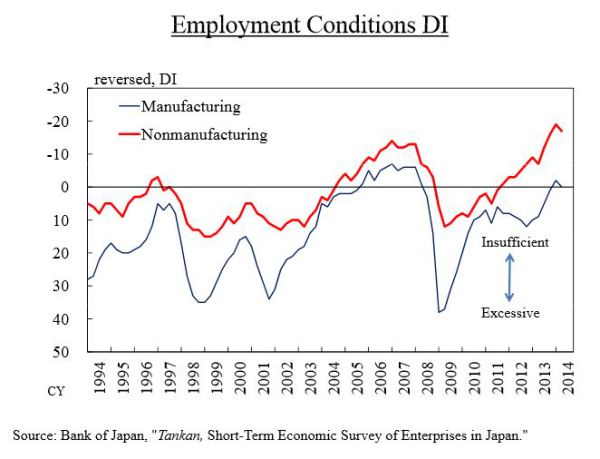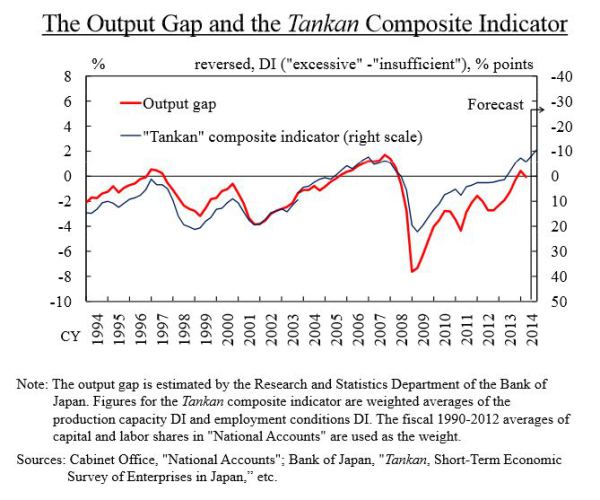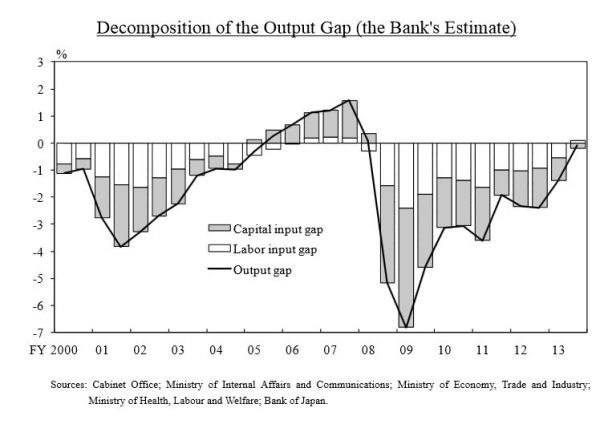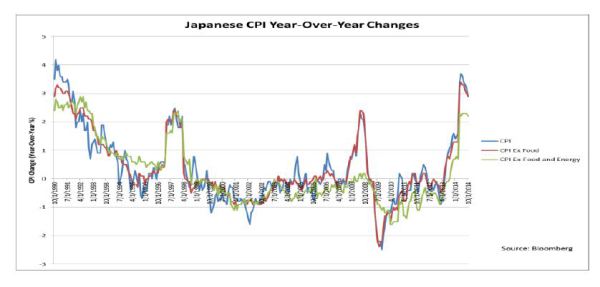For years – if not decades – Japan’s shrinking demographics have been a primary cause for that country’s lackluster economic growth. However, Japan is now reaching a point in its cycle where the population shortage — combined with a scarcity in natural resources and the effects of “Abenomics” – will cause stagflation rather than deflation. This is a structural rather than cyclical change resulting from a shortage in labor and natural resources. The former is a result of declining population/workforce along with stringent immigration laws and the latter is a result of the closing of nuclear power plants following the 2011 Tohoku earthquake and tsunami.
During the past few years, Japan’s unemployment rate has gradually dropped and is now at 3.5% which is the lowest since 1997.

Drobny Global Advisors, 11 December 2014
Additional signs of improvement within the labor sector are seen in other surveys. For example, the “Jobs-To-Applicants Ratio” is now at a level (1.1 job openings/applicants) not seen since June 1992 when 10-year Japanese Government Bonds (JGBs) yielded 5% (we have only had to move the decimal over to the left one place during the past 22 years):

Drobny Global Advisors, 11 December 2014
Recent Bank of Japan Tankan Surveys show that both the manufacturing and non-manufacturing sectors are finding a shortage of available workers {DI: diffusion index}:

“Japan’s Economy and Monetary Policy“, speech by Ryuzo Miyao, (BoJ Policy Board), 18 Oct 2014
For example, the trucking industry has a shortage of workers and employs as many 80-year olds as it does 20-year olds:

Drobny Global Advisors, 11 December 2014
The Bank of Japan forecasts the economy’s “structural unemployment rate” at 3.5%. In other words, Japan’s unemployment rate is about to go through the rate at which the BoJ thinks is the lower bound:

“Japan’s Economic Activity, Prices, and Monetary Policy: Relationships between the Output Gap, Prices, and Wages“, speech by Sayuri Shirai (BoJ Policy Board), 29 May 2014
As a result of the improving labor situation, Japan’s “output gap” has significantly recovered from the 2009 lows and by some measures the “gap” is now positive.
“Japan’s Economy and Monetary Policy“, speech by Ryuzo Miyao, (BoJ Policy Board), 18 Oct 2014
The “output gap” is the difference between an economy’s aggregate demand and supply capacity or the formula:
Actual GDP – Potential GDP = Output Gap
Actual GDP = Aggregate Demand
Potential GDP = Supply Capacity
Usually the output gap turns positive as a result of an increase in demand relative to supply. However, Japan’s output gap is shrinking NOT because of increasing demand but rather because of the shrinking supply of labor and natural resources.
“Japan’s Economic Activity, Prices, and Monetary Policy: Relationships between the Output Gap, Prices, and Wages“, speech by Sayuri Shirai (BoJ Policy Board), 29 May 2014
This is an important change. Up until now, Japan’s shrinking and aging population resulted in a lack of demand. Now, however, the greatest challenge for Japan’s economy is a shortage of laborers and natural resources. These factors combined with the depreciating Yen and the increase in the VAT have moved inflation to levels not seen in years:
Drobny Global Advisors, 11 December 2014
Both the Abe Administration and the BoJ have a laser-like focus on securing a continued 2% inflation regardless of what the ultimate costs to the economy are. The Liberal Democratic Party is looking to this weekend’s elections as a referendum on “Abenomics”. As the LDP’s campaign slogan states, “There Is No Road But This”. As long as the BoJ continues its QEE policies {quantitative easing or exchange rate intervention} and Japan’s unemployment rate remains low (especially if they are below NAIRU — the non-accelerating inflation rate of unemployment), we do not see credible scenarios for the Yen to strengthen versus the Dollar. Our current target is an exchange rate of 140 Yen/$.
Drobny Global Advisors, 11 December 2014
The LDP is expected to increase its majority in the Lower House with the election. We have rarely seen such a consensus and complacency over election results. In reality, “Abenomics” is just a great transfer of wealth from savers to Japan Inc. If for some reason the electorate decides to protest this and the LDP loses seats – or its majority – we shiver to think what the global financial markets will do. If there ever was a “Black Swan” event, it is this weekend’s election.
Of course, an LDP loss will only put that much more of the onus on the BoJ to expand its quantitative and qualitative easing {QQE}. Therefore, while the Yen could initially strengthen on a LDP “loss”, the markets will eventually realize that reverting back to the status quo of the Democratic Party of Japan (DPJ) or the Communists (who are polling the highest of all opposition parties) will only cause more problems.




